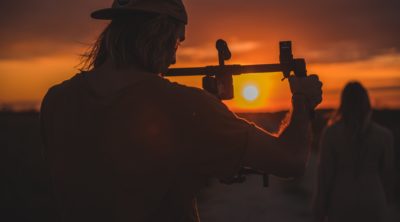< Back to all posts
Remote Video Production Best Practices for Your Business
Where do you film your corporate videos? This is a question that can have a major impact on how those clips turn out, whether they’re commercial videos for potential clients, updates for current customers, training videos for employees or anything in between.
A studio setting allows video creators to have all their equipment close at hand and capture footage in a controlled environment, making it a natural choice for many shoots. However, once companies become more ambitious in their use of corporate video, they can take the filming and video creation process outside for on-location and remote video production.
Filming Remote Content: Why and How?
Filming on location is a way to inject life into videos, taking advantage of backdrops ranging from local landmarks and city skylines to natural landscapes. These varied locations can lend a sense of reality to finished videos, and allow companies to show off their identity to a target audience without dressing a set or projecting a digital backdrop.
When done well, an on-location video shoot can lead to great video content, whether the finished product is an explainer video, a customer testimonial video, a live event promo or any other kind of video content. This leads to an essential follow-up question, however. What do businesses need to keep in mind to make sure their shoots go well?
There are a few categories to look into when incorporating remote videos into an overall video strategy. Planning, technology and expertise are all important components that can lead to good results for businesses. While many organizations won’t have all these traits present in-house, that doesn’t mean they shouldn’t pursue video — it simply indicates they should partner with an expert video production company.
Looking more closely at the various pillars of a successful remote video production can help businesses achieve satisfactory results, whether they’re just getting started with on-location video or they’ve been producing video content this way for years.

Preparation and Strategy
One of the trade-offs involved in an outdoor vs. in-studio video shoot is the amount of control the production team has. When using the natural environment as a backdrop, crews may find themselves at the mercy of the weather, changing light, traffic or one of dozens of other unpredictable factors.
As for whether these issues will derail the video shoot, that often comes down to a crew’s level of advance preparation. If there is a fully mapped out strategy for a given remote production, that can compensate for a number of unplanned issues.
That strategy should encompass:
- Scouting and permit pulling for filming locations: Going into an outdoor video shoot unprepared can cause major problems. For instance, discovering that the crew is not permitted to film in an area can waste a whole day or more. Video producers should take the time to scout all their locations closely and apply for necessary permits. It’s important to bear in mind, too, that drone shots sometimes require separate permits from filming on the ground.
- Selection of alternative and backup locations: Sometimes, a location falls through due to an unplanned closure — what happens then? If a video production has planned ahead, the action can shift to a backup location, enabling progress to continue. This may be as simple as scouting an area with a roof in case the main location is shut down due to rain.
- Scheduling that accounts for weather, traffic and more: Schedules should be realistic. What this means in practice is making plans that crews will actually be able to follow through on. For instance, if a shot is scheduled for rush hour, getting to the location will require extra travel time. Schedules can also have extra days built in in case weather delays shooting, especially valuable in areas with unpredictable climates.
Building out a plan for a shoot is easier when companies work with expert video crews, as these professionals not only have previous experience to fall back on, they are familiar with their areas, and understand local quirks such as permitting processes, traffic patterns and seasonal weather.
Equipment and Technology
The right equipment can represent the difference between a polished, professional-looking video and a clip that doesn’t live up to its potential. Considering the fact that so many companies are using video as part of their marketing, outreach and employee engagement strategies, this level of quality can be a much-needed differentiator.
Having the right mindset around equipment selection and use can make all the difference on a remote video shoot. Having expensive gear isn’t everything — the crew should also be able to select the right asset for any given moment, and understand how to get every ounce of performance out of those tools.
Best practices for equipment use on outdoor video shoots include:
- Packing plenty of gear, including backups and redundant equipment: In the studio, equipment is everywhere. On location, everything needs to come along with the crew. It’s best to fully back up essential gear so a mechanical failure doesn’t stop the shoot.
- Preparing to deal with the lighting conditions on location: Outdoor light is a great asset for video producers, but it’s inherently fickle. Having gear such as neutral density filters for camera lenses, as well as light reflectors and flags, can ensure the natural light looks great.
- Selecting the right microphones for the shoot type: Mic selection is important anywhere, but especially on an outdoor shoot, where wind could interfere with shotgun and boom mics. Packing specialized gear such as wind socks is a good habit for crews to get into.
Gear usage is another area where expert video crews can have a positive influence. These teams are equipped with the latest and best in professional-quality filming equipment. Hiring a crew with high-quality gear is a way to achieve ideal video and audio fidelity without the upfront cost of buying the equipment.
Partnerships and Expertise
Launching a remote production strategy is a bold move for a business, one best accomplished through a strategic partnership. Expertise can boost any aspect of a production — keeping a remote shoot on schedule, directing talent on location, performing video editing and post production — these tasks and more could be best addressed with third party help.
Video crews from Crews Control are made up of experienced professionals who can keep these efforts on the right track and make sure the results are up to viewers’ high standards. As for day-to-day tasks, a director of photography from Crews Control can provide the exact level of support a project requires. This may mean planning out locations, pulling permits, selecting gear, and even choosing the best local spots to get lunch.
Every Crews Control director of photography has at least 10 years of experience — they’ve used that time learning how to get the most out of their regional home bases and internalizing the best practices of video production.
To learn more about all the ins and outs of filming on location, download our ebook. And if your business wants the high-quality results that come along with a remote corporate video production helmed by experts, contact Crews Control today.







Leave a Reply